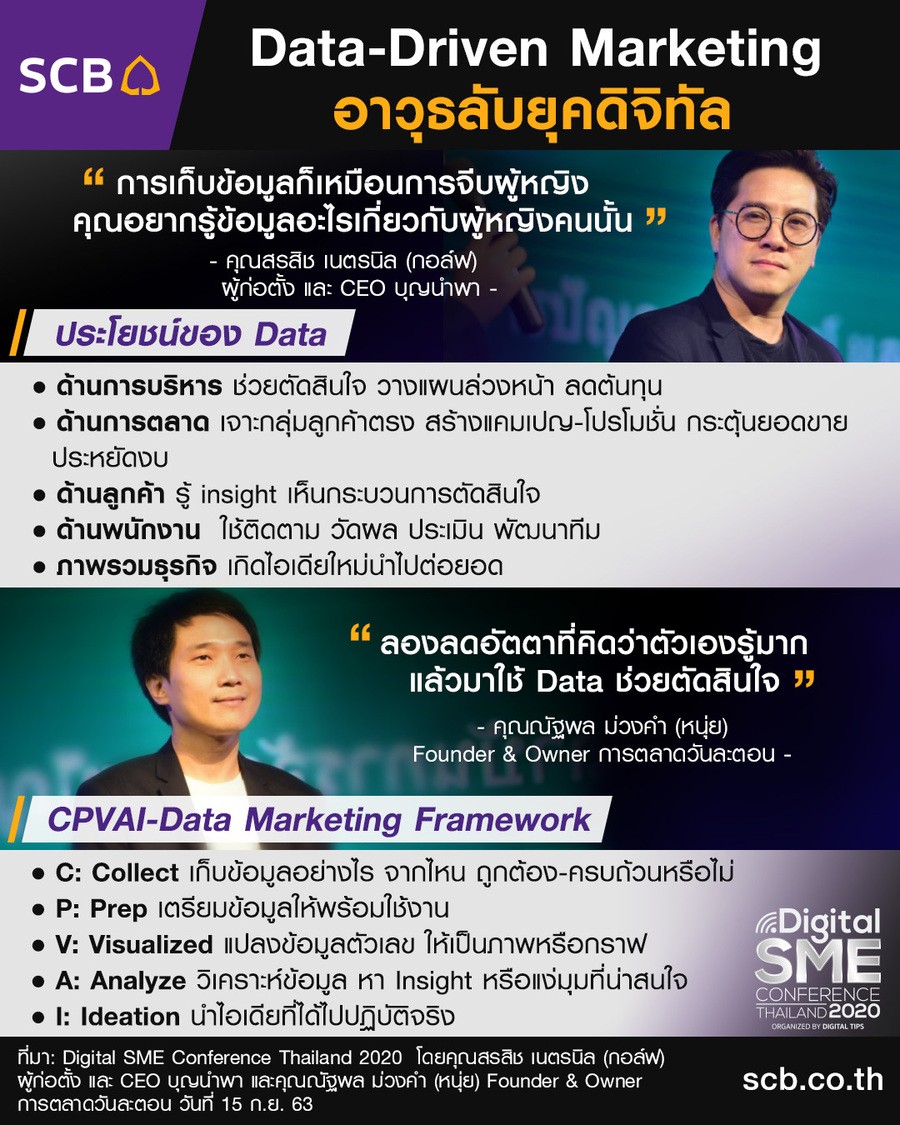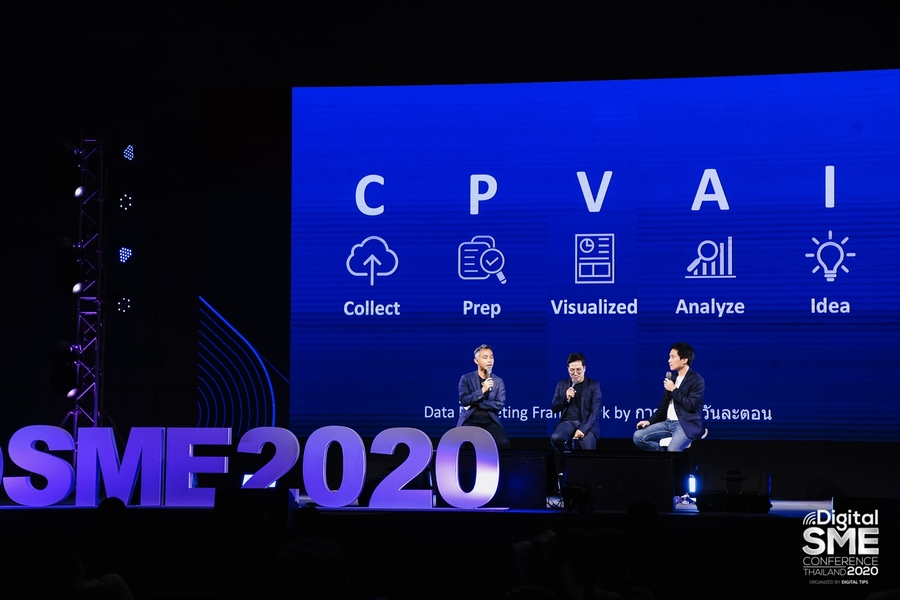I WANT
RELATED LINKS
I WANT
RELATED LINKS
RELATES LINKS
I WANT
RELATES LINKS
Services
Related Links
Use and Management of Cookies
We use cookies and other similar technologies on our website to enhance your browsing experience. For more information, please visit our Cookies Notice.
- Personal Banking
- Stories & Tips
- BUSINESS MAKER
- Data Driven Marketing –A Secret Weapon to Fight in Digital Era
- Personal Banking
- ...
- Data Driven Marketing –A Secret Weapon to Fight in Digital Era
Data Driven Marketing –A Secret Weapon to Fight in Digital Era
02-10-2020
In an era that entrepreneurs need data to develop their business, some might have a question of what will come next after data collection, how to analyze information, and how much data needed to be collected to be sufficient. At Digital SME Conference Thailand 2020, Sorasich Natenin (Golf), Founder and CEO of Boonumpar who develop his business by using data to capture customers’ insight, was invited. He came up with ideas that led to the success and various expansion of his business such as “Boonumpar”, “Hong Catering”, “BNP Cuisine” and Mr.CHON. Another guest speaker is Nattapon Muangkham (Nui), Founder and Owner of EverydayMarketing.co, who is a marketing consultant, guest lecturer at university, and an author of the best-selling book titled “Data-Driven Marketing”. Both of them came to share their experiences from using data in the business to SME entrepreneurs as a starting idea to manage their own data.

Data collection using Excel program
Some of the entrepreneurs might have no idea how to do data collection. Golf, Founder and CEO of Boonumpar, shared that we have to imagine when we want to ask a lady out for a date. We have to think about what we want to know about her. Of course, we want to know her name, mobile number and where she lives. All that mentioned are like the collection of customer information to get to know each other more.
On the other hand, Nui, the administrator of EverydayMarketing.co page, suggested that data has to be collected from the total sale because it will allow us to know the daily situation of the business. We will know the days with good sales and days with low sales. Then we can proceed on the list of what sells well and who the customers are. The majority of entrepreneurs know the daily total sale, but do not know which group of customers contributed to the sale. Thus, the important thing is to know from who and from what did the money comes as well as when the money came from. Next, group the customers. For example, the number of regular and casual customers, the sale gained from each group, and what products made the highest sale. All these can be gained from data. Not something we have to find out ourselves. In case it is an offline business, how do entrepreneurs look for customer information? Nui gave an example of the food stalls. If they have POS machine, customers’ orders can be recorded. However, if they are small food stalls, it is suggested that they list orders down on paper and type the list in the LINE application. At the end of the day, they have to gather all information down on Excel once more and this is the way to easily collect data.

How to use data to bring success to the business
As a business owner who makes use of data, Golf said that when his business was still small, he filled up the information on quotations into Excel. But, when his business has expanded, ERP software is used to collect data. For example, “Boonruksa”. This business collects information like mobile number, address, venue, number of monks, nearby temples, number of monks in the temple, etc. The information collected is very detailed and when they are doing online marketing and want to know which platform the sale comes from, the method used would be 1 number 1 platform. This will allow him to know the platform and from which post that the customers come. Then hashtags will be used such as new customer, not yet confirmed. So that, special offers will be sent directly to particular customers and this actually helps to save a lot of marketing cost.
Nowadays, linking all information from social media through an ERP system is easy for data management. It allows classification of customers to be easier and niche marketing to be possible. Also, the process of contacting and decision making of customers can be clearly viewed and planning can be done entirely as well as overseeing the staff performance to further improve the team. Data collection, thus, leads him to see that customers order food to give alms and this paves the way to the new business idea, “BNP Cuisine” that comes with a frozen delivery service.

As for Nui, who is a consultant for many SMEs, he shared case studies from using data in business. The example he gave was a floristry business with 7-8 branches. When they started collecting data, they found out that Chidlom branch made more sales on flowers that are commonly used for merit-making and wreaths while Thonglor branch’s best-seller were lily, flower bouquet, or decorating flowers. From the data, it can be seen that different branches have different best seller products. If we superficially take the information, we would think that Chidlom branch should have more variety of wreaths on sale and Thonglor branch should have more lily, flower bouquet and decorating flower. However, the next thing that we should do is to find out why these products become best sellers. If we observe the shop in Chodlom branch, we will see that majority of customers are female upper-class missus who buys flowers to mainly make merit at the temple. On the other hand, customers at Thonglor branch consist mainly of foreigners who stay in the nearby condominium and purchase flowers to decorate their room. According to the observation, we can suggest the floristry to sell more related products. For example, the Chidlom branch can sell candles and incenses along with flowers, and Thonglor branch can display room decorating products on their shelves and sell them together with flowers. We can see that by analyzing the sales data, we can discover the target groups as well as the related products
Another case study is the shoe business in e-commerce. There is an analysis of sales and it shows that the business has 25% regular customers, but they made multiple purchases and contribute up to 48% of the total sale. When this information is obtained, if the business has a limited marketing budget, they can be more specific on the target group they should focus on. When they dig deeper into the data, they found out that regular customers will return to purchase again at an average of 3 times every 80-90 days. This means the shop does not have to send promotions to customers before the 80-90 day date because customers are likely to purchase without getting any discount. Or, if the data shows that there are 3 times more female customers in Rayong compared to other cities, they have to go deeper into the data and find out the reason. Ultimately, the important thing is to know how to make a promotion that is related to the products. If we gain the data, we can come up with promotions that are more appealing to the customers and sales can be generated faster. This is the benefit that SMEs will get by using data from e-commerce or marketplace to develop their business.

Identity VS Anonymous
Nui felt that anonymous data will at least allow the business to know the trend, overview, and some insights –such as best-selling product, peak period, and target group –and this overall picture can be brought to plan a marketing strategy. However, if the data is identifiable, businesses will be able to do segmentation and know more about customers, in-depth. At the same time, Golf said that if we can measure and collect data from social media platforms, we will know if our marketing plan is done on a suitable channel. For example, a Facebook advertisement will flash according to the target group, interest, and age. We have to check if these are our real targets. Besides, he felt that data collection will help to reduce cost, manage and organize, plan, help us come up with sales strategy, make promotion, measure efficiency and accurately evaluate staff.

Problems with Thai SMEs and data usage
Nui shared that from his conversation with most SMEs, he found out that they have no idea what to do after data collection because they did not set a clear goal. Another hurdle is the mindset that they have known enough because they have experience and disregard data while making decisions. For example, Nui had an endless conversation with his editor on the Thai name of his latest book. So, they flashed 4 advertisements to test the response of the customers to see which Thai name customers would want to buy the book most. After 2 weeks, they came to the conclusion without having to argue. By creating assumptions and carry out the experiment, we will reach the right conclusion. At the same time, Golf said that many business owners did not use data to their advantage despite being able to collect a lot of data and it is such a waste.

CPVAI –Data Marketing Framework
To allow entrepreneurs to benefit from the data, Nui gathered all his experiences on data marketing and shared them through the CPVAI model. He advised business owners to set a clear goal on what they want to know before collecting data according to the mentioned model. The CPVAI model consists of:
- C: Collect This is considered the most important step in data collection. We have to know how to obtain the information, from where the information comes from, and know if we have all the information we need to work on.
- P: Prep (Data Preparation) It is important for the data to be readily prepared because it comes from several sources and is being collected many times. Thus, it has to be ready for use.
- V: Visualized Changing numeral data into a picture or graph will help us to easily see the information.
- A: Analyze Data analysis can be done by searching for insight or interesting aspects from the graph.
- I: Ideation When insight is obtained, an idea has to be experimented with to improve the marketing plan or change advertising methods or work system in the organization because if data is analyzed, but not brought to use, it will be rendered useless.
Above all, apart from data collection, SMEs should not overlook customer data protection. Therefore, this information must be protected with a passcode before access or download and the identity of customers should be made anonymous by using numeral codes to represent the customers. This will make data protection secured and up to standard. Besides, staff involved should sign a contract regarding data protection. This will be another way to secure the information and prevent the violation of using information inappropriately. More importantly, when data is collected, do not forget to use it to our advantage. Only then that entrepreneurs will see the beauty of using data in their business and it will help them to decide, manage, boost sales and create income tremendously for their business, in a way that has never happened before.
Citation: Digital SME Conference Thailand 2020 by Sorasich Natenin (Golf), Founder and CEO of Boonumpar and Nattapon Muangkham (Nui), Founder and Owner of EverydayMarketing.co
